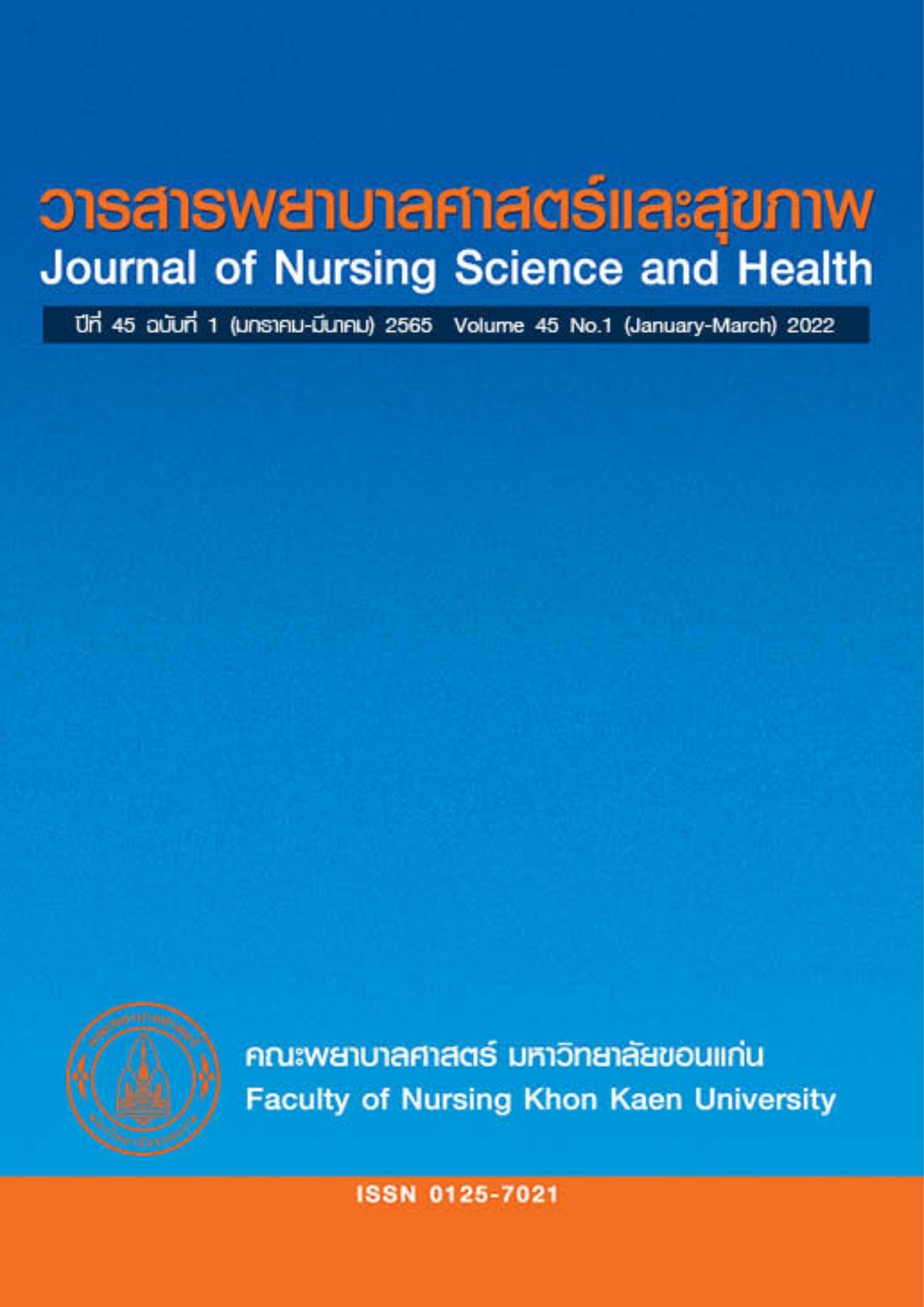ผลของโปรแกรมการสอนบนแนวคิดภาพสะท้อนทางความคิดผ่านแอปพลิเคชันไลน์ต่อผลลัพธ์ที่คัดสรรในผู้ป่วยโรคไตเรื้อรังระยะที่ 3 ที่มีอัตราการทำงานของไตลดลงอย่างรวดเร็ว
คำสำคัญ:
โปรแกรมการสอนบนแนวคิดภาพสะท้อนทางความคิด, แอปพลิเคชันไลน์, ผู้ป่วยโรคไตเรื้อรังระยะ ที่ 3 อัตราการทำงานของไตลดลงอย่างรวดเร็วบทคัดย่อ
การวิจัยนี้มีวัตถุประสงค์เพื่อศึกษาผลของโปรแกรมการสอนบนแนวคิดภาพสะท้อนทางความคิดผ่านแอปพลิเคชันไลน์ ในผู้ป่วยโรคไตเรื้อรังระยะที่ 3 ที่มีอัตราการทำงานของไตลดลงอย่างรวดเร็วต่อผลลัพธ์ทีคัดสรร สุ่มตัวอย่าง จำนวน 50 ราย เข้าศึกษาจากผู้ป่วยที่มารับการตรวจรักษาที่คลินิกเบาหวาน-ความดันโลหิตสูงแผนกผู้ป่วยนอก โรงพยาบาลนครพนม โดยสุ่มกลุ่มตัวอย่างเข้ากลุ่มทดลองและกลุ่มควบคุมกลุ่มละ 25 ราย ดำเนินการเก็บข้อมูลในเดือนมีนาคม-พฤษภาคม 2564 เครื่องมือที่ใช้ในการเก็บรวบรวมข้อมูล ประกอบด้วย แบบสอบถามภาพสะท้อนทางความคิดต่อการเจ็บป่วย และแบบสัมภาษณ์พฤติกรรมสุขภาพ เครื่องมือที่ใช้ ในการทดลองเป็นโปรแกรมการสอนบนแนวคิดภาพสะท้อนทางความคิดผ่านแอปพลิเคชันไลน์ ประกอบด้วย ชุดสื่อการสอน คู่มือ และแบบบันทึกการติดตามตนเอง ซึ่งได้ผ่านการตรวจสอบความตรงจากผู้ทรงคุณวุฒิ 5 ท่าน ได้ค่าดัชนีความตรงเท่ากับ .86 วิเคราะห์ข้อมูลด้วยสถิติเชิงบรรยายและสถิติอ้างอิง
ผลการวิจัยพบว่า ภายหลังการทดลองกลุ่มทดลองมีค่าคะแนนเฉลี่ยการรับรู้ความเจ็บป่วย คะแนนเฉลี่ยพฤติกรรมสุขภาพและอัตราการกรองของไตสูงกว่ากลุ่มควบคุมอย่างมีนัยสำคัญทางสถิติ (p<.05) และกลุ่มทดลองมีค่าเฉลี่ยระดับความดันโลหิตตัวบน ค่าเฉลี่ยระดับความดันโลหิตตัวล่างและค่าไมโครอัลบูมินนูเรียในปัสสาวะต่ำกว่ากลุ่มควบคุมอย่างมีนัยสำคัญทางสถิติ (p<.05)
ผลการวิจัยนี้แสดงให้เห็นว่า โปรแกรมการสอนบนแนวคิดภาพสะท้อนทางความคิด สามารถช่วยให้ผู้ป่วยโรคไตเรื้อรังระยะที่ 3 ที่มีอัตราการทำงานของไตลดลงอย่างรวดเร็ว มีการรับรู้ความเจ็บป่วยที่สอดคล้องกับทางการแพทย์ ส่งผลให้มีพฤติกรรมสุขภาพและตัวชี้วัดทางคลินิกเปลี่ยนแปลงไปในทางที่ดีขึ้น
เอกสารอ้างอิง
Ministry of Public Health. Workshop to develop and optimize NCD surveillance system and NCD prevention and control in district level networks [internet]. Nonthaburi: Ministry of Public Health; 2018 [cited 2018 Mar 3]. Available from: http://1ab.in/phn.
Senanayake S, Gunawardena N, Palihawadana P, Bandara P, Haniffa R, Karunarathna R, et al. Symptom burden in chronic kidney disease: A population based cross sectional study. BMC Nephrology2017;18(1):228.DOI10.1186/s12882-017-0638-y
Mallappallil M, Friedman A, Delano G, McFarlane I, Salifu O. Chronic kidney disease in the elderly: Evaluation and management. Clinical Practice (London, England) 2019; 11(5): 525-35.
Chen HC, Lin HJ, Huang CC, Chang CT, Chou CY. Maximum glomerular filtration decline rate is associated with mortality and poor renal outcome in chronic kidney disease patients. Blood Purification 2019; 48(2):131–7.
Ricardo AC, Anderson CA, Yang W, Zhang X, Fischer MJ, Dember LM, et al. Healthy lifestyle and risk of kidney disease progression, atherosclerotic events, and death in CKD: Findings from the chronic renal insufficiency cohort (CRIC) study. Am J Kidney Dis 2015;65(3): 412-24. Doi: 10.1053/j.ajkd.2014.09.016
Levey AS, Becker C, Inker LA. Glomerular filtration rate and albuminuria for detection and staging of acute and chronic kidney disease in adults: A systematic review. JAMA 2015; 313(8): 837–46.
Leventhal H, Meyey D, Nerenz, D. The common-sense representation of illness danger In: Rachman S, editor, Contributions to medical psychology: New York: Pergamons; 1980.
Lerlak L. The effect of an illness-representationbased health education program on the health behaviors and clinical outcomes of patients with chronic kidney disease undergoing hemodialysis [thesis]. Bangkok: Thammasat university; 2017. (in Thai)
Mao E, Pattama S. Effect of an education program-based on the common sense model illness perceptions, knowledge, and self-efficacy among patients with type 2 diabetes mellitus in combodia. NURS SCI J THAI 2019; 37(4):20-31. (in Thai)
Stevenson JK, Campbell ZC, Webster AC, Chow CK, Tong A, Craig JC, et al. eHealth interventions for people with chronic kidney disease. Cochrane Database of Systematic Reviews 2019: 1-15.
Jirawatkul A. Statistics for health science research. Bankok: Witayaphat; 2015.
Parinya H, Nonglak M. Illness representation of patient with chronic kidney disease stage 3 with a rapid decline of kidney function. Journal of Nursing and Health Care 2019; 37(4): 216-24. (in Thai)
Leventhal H, Phillips LA, Burns E. The common-sense model of self-regulation (csm): A dynamic framework for understanding illness self-management. J Behav Med 2016; 39(6):935-46.
Angeli F, Verdecchia P, Poltronieri C, Bartolini C, Filippo V, Ambrosio CD, et al. Ambulatory blood pressure monitoring in the elderly: Features and perspectives. NMCD 2020; 24(10): 1052-6. doi: 10.1016/j.numecd.2014.04.004
Klatinpoo B, Oba N, Neawbood S. Effects of a behavioral modification program in complication control of diabetes patients with chronic kidney complications. Journal of Health and Nursing Education 2020; 26(1):58-70. (in Thai)
Moungyeam S, Naewbood S, Rithpho P. Effects of health promotion program on health behavior and estimated glomerulus filtration rate among patients with chronic kidney disease stage 3. Journal of Nursing and Health Sciences 2018;12 (supplement): 97-109. (in Thai)
ดาวน์โหลด
เผยแพร่แล้ว
รูปแบบการอ้างอิง
ฉบับ
ประเภทบทความ
สัญญาอนุญาต
ลิขสิทธิ์ (c) 2022 วารสารพยาบาลศาสตร์และสุขภาพ

อนุญาตภายใต้เงื่อนไข Creative Commons Attribution-NonCommercial-NoDerivatives 4.0 International License.
วารสารพยาบาลศาสตร์และสุขภาพเป็นเจ้าของลิขสิทธิ์ในการเผยแพร่ผลงานที่ตีพิมพ์ห้ามผู้ใดนำบทความที่ได้รับการตีพิมพ์ในวารสารพยาบาลศาสตร์และสุขภาพไปเผยแพร่ในลักษณะต่าง ๆ ดังนี้ การนำบทความไปเผยแพร่ออนไลน์ การถ่ายเอกสารบทความเพื่อกิจกรรมที่ไม่ใช่การเรียนการสอน การส่งบทความไปตีพิมพ์เผยแพร่ที่อื่น ยกเว้นเสียแต่ได้รับอนุญาตจากวารสารพยาบาลศาสตร์และสุขภาพ



